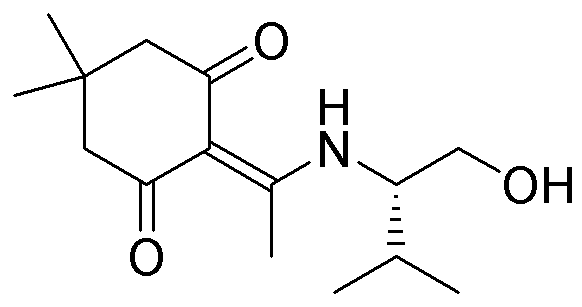Na-1-(4,4-dimethyl-2,6-dioxocyclohex-1-ylidene)ethyl-L-valinol is widely utilized in research focused on:
- Pharmaceutical Development: This compound is explored for its potential in developing new medications, particularly in the field of pain management and anti-inflammatory drugs.
- Biochemical Research: It serves as a valuable tool in studying enzyme interactions and metabolic pathways, helping researchers understand complex biological processes.
- Organic Synthesis: The compound is employed in synthetic organic chemistry as a building block for creating more complex molecules, offering versatility in various chemical reactions.
- Agricultural Chemistry: It is investigated for use in developing agrochemicals, potentially leading to more effective pesticides and herbicides that are safer for the environment.
- Material Science: The compound is being studied for its properties in creating new materials with enhanced performance, such as polymers with improved durability and resistance.
General Information
Properties
Safety and Regulations
Applications
Na-1-(4,4-dimethyl-2,6-dioxocyclohex-1-ylidene)ethyl-L-valinol is widely utilized in research focused on:
- Pharmaceutical Development: This compound is explored for its potential in developing new medications, particularly in the field of pain management and anti-inflammatory drugs.
- Biochemical Research: It serves as a valuable tool in studying enzyme interactions and metabolic pathways, helping researchers understand complex biological processes.
- Organic Synthesis: The compound is employed in synthetic organic chemistry as a building block for creating more complex molecules, offering versatility in various chemical reactions.
- Agricultural Chemistry: It is investigated for use in developing agrochemicals, potentially leading to more effective pesticides and herbicides that are safer for the environment.
- Material Science: The compound is being studied for its properties in creating new materials with enhanced performance, such as polymers with improved durability and resistance.
Documents
Safety Data Sheets (SDS)
The SDS provides comprehensive safety information on handling, storage, and disposal of the product.
Product Specification (PS)
The PS provides a comprehensive breakdown of the product’s properties, including chemical composition, physical state, purity, and storage requirements. It also details acceptable quality ranges and the product's intended applications.
Certificates of Analysis (COA)
Search for Certificates of Analysis (COA) by entering the products Lot Number. Lot and Batch Numbers can be found on a product’s label following the words ‘Lot’ or ‘Batch’.
Numéro de catalogue
Numéro de lot/série
Certificates Of Origin (COO)
This COO confirms the country where the product was manufactured, and also details the materials and components used in it and whether it is derived from natural, synthetic, or other specific sources. This certificate may be required for customs, trade, and regulatory compliance.
Numéro de catalogue
Numéro de lot/série
Safety Data Sheets (SDS)
The SDS provides comprehensive safety information on handling, storage, and disposal of the product.
DownloadProduct Specification (PS)
The PS provides a comprehensive breakdown of the product’s properties, including chemical composition, physical state, purity, and storage requirements. It also details acceptable quality ranges and the product's intended applications.
DownloadCertificates of Analysis (COA)
Search for Certificates of Analysis (COA) by entering the products Lot Number. Lot and Batch Numbers can be found on a product’s label following the words ‘Lot’ or ‘Batch’.
Numéro de catalogue
Numéro de lot/série
Certificates Of Origin (COO)
This COO confirms the country where the product was manufactured, and also details the materials and components used in it and whether it is derived from natural, synthetic, or other specific sources. This certificate may be required for customs, trade, and regulatory compliance.


